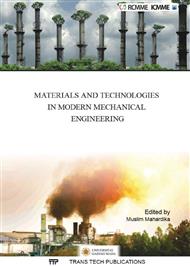[1]
Guillem Quintana, Joaquim Ciurana, Chatter in machining processes: A review, International Journal of Machine Tools & Manufacture 51 (2011), p.363–376.
DOI: 10.1016/j.ijmachtools.2011.01.001
Google Scholar
[2]
Duncan, G.S. and Schmitz, T. (2005) : An improved RCSA model for tool point frequency response prediction, Proceedings of the 23rd International Modal Analysis Conference, Orlando, F.
Google Scholar
[3]
J.V. Le Lan, A. Marty, J.F. Debongnie, CIRP (Eds. ), A stability diagram computation method for milling adapted to automotive industry, in: Proceedings of the CIRP 2nd International Conference on High Perfor- mance Cutting, 12–13 June 2006, Vancouver, British Columbia, Canada, (2006).
Google Scholar
[4]
S.A. Tobias, W. Fishwick, Theory of regenerative machine tool chatter, The engineer 1958258.
Google Scholar
[5]
N.H. Hanna, S.A. Tobias, Theory of nonlinear regenerative chatter, Journal of Engineering for Industry, Transactions of the ASME 96 Ser B(1), 1974, p.247–255.
DOI: 10.1115/1.3438305
Google Scholar
[6]
Ruxu Du, M. A. Elbestawi, B. C. Ullagddi, Chatter detection in milling based on the probability distribution of cutting force signal, Mech. Systems and Signal Processing, 1992, 6(4), pp.345-362.
DOI: 10.1016/0888-3270(92)90036-i
Google Scholar
[7]
Altintas, Y.; Chan, P.K. (1992), In-process detection and suppression of chatter in milling, International Journal of Machine Tools and Manufacture, 32, 329–347.
DOI: 10.1016/0890-6955(92)90006-3
Google Scholar
[8]
E. Kuljanic, M. Sortino, G. Totis, Multisensor approaches for chatter detection in milling, Journal of Sound and Vibration, Volume 312, Issues 4–5, 20 May (2008), pp.672-693.
DOI: 10.1016/j.jsv.2007.11.006
Google Scholar
[9]
B.R. Patel, B.P. Mann, K.A. Young, Uncharted islands of chatter instability in milling, International Journal of Machine Tools and Manufacture, Vol. 48/1 (2008), pp.124-134.
DOI: 10.1016/j.ijmachtools.2007.06.009
Google Scholar
[10]
Luciano Vela-Martínez, Juan Carlos Jáuregui-Correa, José Álvarez-Ramírez, Characterization of machining chattering dynamics: An R/S scaling analysis approach, International Journal of Machine Tools and Manufacture, Volume 49, Issue 11, September (2009).
DOI: 10.1016/j.ijmachtools.2009.05.010
Google Scholar
[11]
Ramin Rahnama, Mozhdeh Sajjadi, Simon S. Park, Chatter suppression in micro end milling with process damping, Journal of Mat. Processing Technology, Vol. 209(17), (2009), pp.5766-5776.
DOI: 10.1016/j.jmatprotec.2009.06.009
Google Scholar
[12]
E. Kuljanic, G. Totis, M. Sortino, Development of an intelligent multisensor chatter detection system in milling, Mech. Systems and Signal Proc. Vol. 23, Issue 5, July (2009), pp.1704-1718.
DOI: 10.1016/j.ymssp.2009.01.003
Google Scholar
[13]
W.X. Tang, Q.H. Song, S.Q. Yu, S.S. Sun, B.B. Li, B. Du, X. Ai, Prediction of chatter stability in high-speed finishing end milling considering multi-mode dynamics, Journal of Materials Processing Technology, Volume 209, Issue 5, 1 March (2009).
DOI: 10.1016/j.jmatprotec.2008.06.003
Google Scholar
[14]
Guillem Quintana, JoaquimCiurana, Ine´s Ferrer, Ciro A. Rodrı´guez, Sound mapping for identification of stability lobe diagrams in milling processes, International Journal of Machine Tools & Manufacture 49 (2009), p.203–211.
DOI: 10.1016/j.ijmachtools.2008.11.008
Google Scholar
[15]
S. S. Park and R. Rahnama, Robust chatter stability in micro milling operations, " CIRP Annals: Manufacturing Technology, vol. 59, no. 1, (2010), p.391–394.
DOI: 10.1016/j.cirp.2010.03.023
Google Scholar
[16]
Yinuo Shi, Frederik Mahr, Utz von Wagner, Eckart Uhlmann, Chatter frequencies of micromilling processes: Influencing factors and online detection via piezoactuators, International Journal of Machine Tools and Manufacture, Volume 56, May (2012).
DOI: 10.1016/j.ijmachtools.2011.12.001
Google Scholar
[17]
Hongrui Cao, Bing Li, Zhengjia He, Chatter stability of milling with speed-varying dynamics of spindles, International Journal of Machine Tools & Manufacture 52 (2012), p.50–58.
DOI: 10.1016/j.ijmachtools.2011.09.004
Google Scholar
[18]
Hongrui Cao, Yaguo Lei, Zhengjia He, Chatter identification in end milling process using wavelet packets and Hilbert–Huang transform, International Journal of Machine Tools & Manufacture 69 (2013), p.11–19.
DOI: 10.1016/j.ijmachtools.2013.02.007
Google Scholar
[19]
E. Graham, M. Mehrpouya, S.S. Park, Robust prediction of chatter stability in milling based on the analytical chatter stability, Journal of Manufacturing Processes 15 (2013), p.508–517.
DOI: 10.1016/j.jmapro.2013.08.005
Google Scholar
[20]
Siddhpura, M. and Paurobally, R. (2012) : A review of chatter vibration research in turning", International Journal of Machine Tools and Manufacture, 61, p.27 – 47.
DOI: 10.1016/j.ijmachtools.2012.05.007
Google Scholar
[21]
P. P. Pandian, V. P. Raja, K. Sakthimurugan, Identification of stability lobes in high-speed machining of thin ribs, Research Inventy: Intl. Journal of Eng. and Sci., 1 (8), (2012) p.01 – 06.
Google Scholar
[22]
Y. Altintas, E. Budak, Analytical Prediction of Stability Lobes in Milling, CIRP Annals - Manufacturing Technology, Vol. 44, Issue 1 (1995), pp.357-362.
DOI: 10.1016/s0007-8506(07)62342-7
Google Scholar
[23]
Y. Altintas, M. Weck, Chatter Stability of Metal Cutting and Grinding, CIRP Annals - Manufacturing Technology, Vol. 53, 2 (2004), pp.619-642.
DOI: 10.1016/s0007-8506(07)60032-8
Google Scholar


